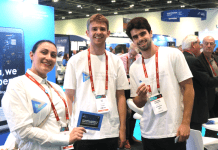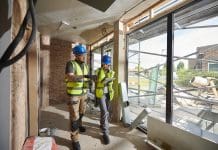How the NHS Estates are developing BIM, the NEC3 and IoT are all addressed in an interview with Karl Redmond, Director of both BIM4HEALTH and BIM4SME UK Groups
In this interview with Karl Redmond MSc, we tackle how NHS Estates can benefit from BIM, how the NEC3 contracts and the new Procure22 Framework enable the all-important collaboration required for BIM to be successful, and how data will be collected and analysed. We also outline the latest on the pilot projects developed by Enable by Design who are aiming to tackle the cultural and technological barriers that can cause difficulties when attempting to create positive, highly disruptive, efficient and joined up clinical and physical asset care initiatives.
The NHS ‘Five Year Forward View’ report highlighted the need to capitalise on the information (digital) revolution and the opportunities it presents but are NHS estates ready and able to engage in the BIM process? Will EIRs etc. be clear?
There are a growing number of strategic documents and initiatives which support, dovetail and follow up on the Five Year Forward View report, all of which need combining and coordinating then disseminating down to those on the front line. NHS Estate teams should be part of the dissemination target group. They need to understand the strategies being developed on a local level in order to place into context their own part in the plan, and how they can maximise their offering for the benefit of the Trust and more importantly, their patients.
The Building Information Modelling (BIM) process is now seen as mandatory for public sector projects. “BIM is essentially value creating collaboration through the entire life-cycle of an asset, underpinned by the creation, collation and exchange of shared models and intelligent, structured data attached to them” (UK BIM Task Group). It is seen as a way “Government as a client can derive significant improvements in cost, value and carbon performance through the use of open, shareable asset information” (Department for BIS). It could be said that the public sector, as clients, are buying data not just the physical asset through the adoption of the process.
The first requirement some deal with when entering the BIM process will be the need to create Employers Information Requirements (EIRs), but these require a degree of context when examining how to maximise a specific asset refurbishment or new build project. Supporting the EIRs should be questions relating to Asset Information Requirements (AIRs) and Organisational Information Requirements (OIRs) for the project (amongst other essential information), or put another way, what information do I know and want? What positive whole life outcomes do I want? What should this look like? How should this be presented? And many more. All matters and questions that should be developed with the end in mind, in this instance the betterment of the patient experience and output in a more efficient manner.
The questions above can come from a number of sources, and the outputs will differ, dependent on the perspective and output requirement, but ultimately all should be focused on the patient. This type of thinking and questioning highlights is the need for collaboration, coordination and communication between groups and teams, internally and externally. You cannot develop robust responses to the above while working in silos; although short-term stop-gaps may be possible, long-term sustainable programs are not and never will be.
The NHS, including the Estates teams, don’t need more reactive, short term, stop gaps, they require sustainable transformational plans coupled with operational and performance understanding and improvements, while simultaneously factoring in greater accountability regarding strengthening financial performance. Sound familiar? In the last six months, the NHS has produced, at different times, a number of reports/strategies targeting (currently) silo-based groups in the NHS:
A. Sustainability and Transformation Plans (STPs) – “will be place-based, multi-year plans built around the needs of local populations. STPs will help drive a genuine and sustainable transformation in health and care outcomes between 2016 and 2021. They will also help build and strengthen local relationships, enabling a shared understanding of where we are now, our ambition for 2021 and the concrete steps needed to get us there”. (NHS, March 2016).
B. Strengthening Financial Performance and Accountability 2016/17 – “sets out action to stabilise NHS finances in 2016/17, provides further detail on access to the Sustainability and Transformation Fund (STF) in 2016/17, outlines the proposed basis for assessing the financial performance of provider organisations, and introduces new programmes of financial special measures for providers and commissioners that are unable to ensure sufficient financial discipline”. (NHS Improvement, July 2016).
C. Operational Productivity and Performance in English NHS Acute Hospitals – “the biggest challenge for the NHS in 2016 is to deliver the changes needed to achieve the efficiency and productivity improvements required by 2020. Rapid, effective adoption and implementation of the recommendations by the leaders of our acute hospitals and those that work with them is imperative if we are to achieve this aim; as will be the engagement of NHS Improvement when it comes into being in April this year”. (An independent report for the Department of Health by Lord Carter of Coles, February 2016).
The above, as a collective, provides a strategic vision of what is required and what may be achieved, but it does not mention the tools, technologies and methodologies that may help deliver measurable and sustainable outputs that could support the underlying vision set out in each report. There is no mention of Building Information Modelling (BIM) or the potential it may provide if tackled in a systematic way, albeit, this is just one tool in a systematic process.
With this in mind, the question asked, ‘Are NHS estates ready and able to engage in the BIM process?’, should lead you to one conclusion – No, but given the right guidance they are able. So, who should take responsibility in developing an understanding in what this process can offer? How is this information-rich process added to the broader plans set out in the various reports produced by the various groups? Can local Trust strategic plans be disseminated, contextualised and utilised in developing the OIRs, AIRs and EIRs? Who is joining up the key components and communicating with the Estates teams so they can become more proactive rather than reactive in their approach?
How will the NEC3 contracts, and the new Procure22 Framework enable the all-important collaboration required for BIM to be successful?
The NEC contract is defined as a collaborative form of contract and is created on the basis of good project management principles. Primarily it deals with how to ensure that things go right as opposed to what to do when they go wrong. Research evidences that out of all the projects which are contended in the courts, 95% of the costs of any claims succeeding are forensic, it would be far better to deploy the time, effort and resources to ensure that the project succeeds in the first place. P21 and P21+ have successfully introduced the NEC contract as the mainstay of its procurement and contracting strategy. In particular, the use of Main Option C together with the Pain/Gain mechanism encourages the project team as a whole to focus their abilities on the creation of the right scope with the right budget and appropriate schedule, while recognising the need to reward innovation.
BIM from the outset has allowed project teams to collaborate, this has been seen to take hold particularly in the design stage of the project, and is increasingly capable in supporting and driving collaboration in construction and operation. This is achieved through the deployment of the technology to allow the parties to a contract to be better able to determine what needs to be done, when and how. True digital or virtual prototyping allows teams to build once in the model and once on site – with zero defects and no reworking. This is not to say that change does not occur which it always will on projects, but here again, BIM allows the design to be better understood by the project stakeholders and then validated and verified by the design and delivery team.
This, in conjunction with the core purpose of the NEC contract – to always be able to determine and understand the effect of change on a project – coupled with the track record established by NHS P21 to deliver projects with certainty and assurance plus a final account within 1 month of Completion, is a far closer and greater attainment of the goals of the Government’s Construction Strategy than many of the other procurement vehicles in either public or private sector.
How will the massive amounts of data involved with such a vast estate be collected and analysed? What data is currently available?
There is a colossal amount of data available to many within NHS estates as well as broader management teams within trusts. For example, ERIC (Estates Return Information Collection) and PLACE (Patient-Led Assessments of the Care Environment) which is collected on behalf of the Department of Health and enables the analysis of Estates & Facilities information. The accuracy and completeness is the responsibility of the reporting organisations, and some have questioned the value of the information which has until recently been inconsistent. The ERIC data is heavily referenced in the Carter Review report published in February 2016. Recommendations from the report are also seen as integral to the reports mentioned previously.
This volume of information within ERIC, despite its historic inconsistencies, should not be ignored as it can provide a starting point and a degree of direction finding for estates teams. However, interpretation and understanding of the data when coupled with strategic plans, as mentioned previously, is not common, and collaboration, communication as well as coordination between the various groups needs to improve if any sense of the data is to be achieved. Without a collective approach and responsibility to developing a robust strategy, the numerous rich data sets will remain in silos and never help in delivering the ultimate aim of the NHS.
Through the work with Enable by Design, we are advancing, with our partners, and beginning to tackle the cultural and technological barriers that can cause difficulties when attempting to create positive, highly disruptive, efficient and joined up clinical and physical asset care initiatives. Utilising the data sets above, amongst many others, along with the skills of our partners and the deep understanding of clients, we have agreed pilot schemes, which will establish the realisable benefits to the Trust and the patients they serve.
The IoT has obvious benefits for healthcare but what does the NHS estate currently use regarding innovative and connected devices?
The honest answer to this question is ‘we don’t know for certain’ there seem to be multiple programs and platforms all of which are run independently of each other. This current position and structure will not advance or encourage innovation. Instead, we already see confusion, frustration with silo thinking and actions. There needs to be a coordinated vision and understanding at the top which in turns needs clear articulation further down the management and worker structure. Without this much-needed clarity and guidance hard pushed teams and front line workers delivering care will be increasingly, stretched, frustrated and ultimately angry which will lead to resistance of seemingly isolated micro changes.
“NHS Providers, the organisation that represents hospitals in England, says unless urgent funding is provided it will have to cut staff, bring in charges or introduce “draconian rationing” of treatment, for example, of non-urgent operations. It highlights that 80% of England’s acute hospitals are in financial deficit, compared with 5% three years ago – while missed A&E waiting time targets have risen from 10% to 90%”. (BBC News, 11 Sep 2016).
The deteriorating position financially and clinically, highlighted above in the recent BBC News report regarding the NHS service is compounded by an increasingly ageing estate which is managed largely on a reactive basis. With no joined up plan to identify and capitalise on, the numerous leverage points which potentially exist as part of regional or local healthcare economies will not be fully realised. These leveraging opportunities can go some way to supporting the financial shortfalls faced by healthcare ‘Providers’ and improve clinical services.
What do the pilot projects mentioned above include? What will be the approach taken? Will it be a whole approach of utilising BIM, NEC3 contracts and the IoT?
The pilot programs being developed by Enable by Design, and close trusted partners, utilise strategic thinking based on the all the reports mentioned during this article and influenced by local requirements. This information is refined to produce a ‘prioritisation program’ based on specific local drivers and demands. All of this then helps identify what programs and infrastructure projects can and will be targeted. The tools and methodologies within the BIM process coupled with NEC3 (a collaborative contractual offering) arrangements are then adopted.
The Internet of Things (IoT) offering allows the project to pull all the data together on flexible and adaptable platforms that can grow with the needs of the healthcare provider (specific NHS Trusts & STPs). Data will feed into an RS SAM offering (developed with trusted partners) which will be the brains/intelligent level that will pull data from the various data sets, standards and contractual arrangements and create useable/shareable outputs. The important point to note with the IoT offering is that it has no boundaries or limits regarding the data it can consume, therefore, it can help with outputs. Our pilot project has no boundaries, which means that we can deal with infrastructure projects initially and then move swiftly into facilities management, inventory, clinical, medical equipment and much more, as and when the client is ready to progress and develop.
There are two pilot projects which will hopefully produce results before the close of 2016 with two separate NHS healthcare providers. The initial outputs to be monitored are dictated by the providers, not the contractors, based on the evidence produced via the strategic planning and assessment process followed by the team and informed and validated by the Providers own data.
Is there a time-frame for the pilot projects along with achievements to be realised?
As mentioned, the pilots should start to produce outputs by the end of December 2016, but this will largely depend on the provider’s input and understanding of the process and the measurable targets we aim to produce. It is anticipated that a full 12 months data can be measured in 2017 with lessons learnt from the two projects shared, along with best practice scenarios.
We should see positive results within several weeks/months after the solution is implemented. Of course, the longer the pilot, the more data, and accurate results on benefits. Identifying the right IoT scenarios and approaches is where we will maximise benefits. This must be coupled with getting forward thinking facilities management (FM) teams onboard and utilising RS SAM effectively, along with all other available tools. This combination of data, technologies and cultural integration is where the biggest challenges will be seen, but none are insurmountable.
Claire Lowe, Estates Director, Medway NHS Trust said that:
“Karl Redmond from Enable By Design has presented The Trust with an opportunity to build a fully connected service by utilising data from the clinical and physical environments. The data is linked, analysed and optimised by the Trust with the support of Enable by Design to understand, manage and improve all aspects of the combined clinical and physical service the Trust and its patient’s demand. The blend of ‘big data’, analytics, BIM, IoT opportunities, NHS expertise, along with open, transparent collaboration and clear communication has already resulted in greater coordination and cooperation. However, the exciting element of the pilot project we have commenced is that this has no limits on what we can achieve, regarding improved services along with cost savings, except those we, as a Trust, place on it.”
What are the expected outcomes of the pilot projects and how will this information be used for future projects?
The initial outputs will include a reduction in downtime, improvements in inventory management, cost savings and equally important, greater collaboration, understanding and communication between clinical decision makers and the supporting groups from within Trusts and/or STPs.
Other benefits as we see it will include, the following; Maintainer/FM productivity & informed decision making; Visibility and control of asset total cost of ownership – important for C-Suite, particularly Head of FM, Purchasing & Finance, and improved longevity & running efficiency of assets. All of which are important and collectively powerful cost saving programs which can lead to ‘capital and revenue’ generation as well as integration with the clinical/patient pathways and service objectives – an aim we all want to achieve.
. . . . . . . . . . . . . . . . . . . . . . . . . . . . . . . . . . . . . . . . . . . . . . .
Karl Redmond MSc
Director of BIM4SME and BIM4HEALTH
Tel: 0113 350 0000













